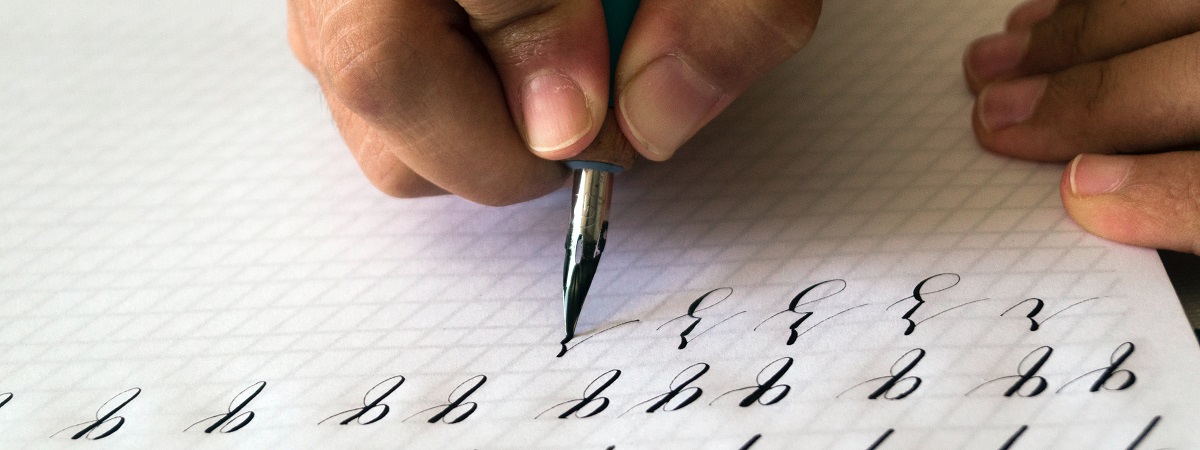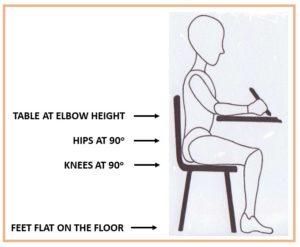
If you’re like me, you wish you’d paid more attention in those first school years when your teacher was showing you the basics of how to hold a pen and write “properly”? But it’s it too late now, right? Or is it possible to improve your handwriting as an adult?
You can improve your handwriting, and you can actually do it quite quickly by paying attention to some simple principles. It takes the right frame of mind, an understanding of the physical mechanics of writing, and the basic fundamentals of a common handwriting style (American cursive, for example).
A lot of people give up on penmanship after elementary school, and end up resorting to things like writing in all caps in an attempt to make their writing look a bit more legible. Or they try to avoid writing anything by hand at all; we have keyboards now, don’t we?
Many school boards, in fact, have now completely removed cursive from the curriculum, and I have to believe that it’s not because the kids are less apt today. It’s because many teachers aren’t confident that they can write well enough themselves. So, what was once a normal part of everyday life is, sadly, becoming a rare skill.
I get it. I had settled for having poor to average handwriting (mostly in caps), and thought that was “my level”. And I’d probably still be thinking that today, but then …
I made a powerful discovery that changed everything
One day I was struggling to understand the meaning of some Bible verses while preparing a sermon, and I decided to write the whole passage out word-for-word by hand. Bam! What a revelation it was. That simple act of copying the Scriptures helped me notice things in the text that I’d never seen before. I started doing it every week as part of my preparation.
To cut a long story short, that insight led me to start the “My Handwritten Bible” project. I was down the rabbit hole. It motivated me to want to improve my handwriting, and so I learned these 7 keys that I’m going to share with you.
Table of Contents
1. Don’t Be Embarrassed About Your Handwriting Right Now
How often has someone passed you a note, even just a phone message or a shopping list, and immediately apologized for their “messy chicken scratch”? If you ask any ten people to rate their own handwriting, at least nine are likely to shuffle their feet and tell you how awful it is.
So, let’s establish one thing right up front — almost all of us (apart from a few art students, maybe) are in the same boat. Why be embarrassed? All that does is create an impediment as you take steps to improve your handwriting. If you see it as a skill to be improved, you can work on it. But too many people see it as a “trait” of who they are, and it paralyzes them.
Here’s the truth …
A) It’s probably not as bad as you think.
It’s like how most people hate hearing their own recorded voice — especially the first time. “I don’t sound like that, do I?” Their friends, however, think it sounds normal and perfectly fine.
My wife, Alli, always asks me to write Christmas and birthday cards to people, because she thinks her handwriting is not as nice. But I look at her writing and honestly see it as SO much better than mine. It’s all in the eye of the beholder.
B) Everyone’s handwriting is unique.
Like your fingerprints, your handwriting is distinctive to you. In fact, handwriting experts are regularly called to give testimony in courts of law, to identify who wrote something.
The goal of improving your handwriting is a good one, but it should not be about all of us having identical Spencerian script. It’s YOUR handwriting, so make peace with that.
C) You CAN improve your handwriting.
Nicer penmanship can give you a lot of satisfaction and more confidence in writing for others. Apply the 7 keys in this post, and you’re going to see improvement, and probably more quickly than you think.
2. Remember the Golden Rule to Improve Your Handwriting: Write Regularly. Write More.
The more you write, the more you develop the “muscle memory” that makes handwriting feel natural and comfortable. Your handwriting becomes more consistent over time, and you gain speed as well.
Once I realized that my handwriting was improving just by the practice of it, I deliberately began to look for more occasions to write every day.
Whereas I used to hardly write anything by hand, now I take every opportunity that I can. I’ve made a habit of:
- Writing cards and letters to people instead of emailing.
- Using a paper planner.
- Taking notes in meetings.
- Journaling.
- My sermons are eventually typed into the computer as a way to archive them, but that’s just the final draft. All my preparation is done longhand.
- I even hand write these blog posts.
If you think about it, you don’t have to find extra hours in your day to improve your handwriting, you can simply incorporate lots of it into your life.
Just one important point to keep in mind. You do want your practice to be the repetition of good principles. (In other words, don’t practice poor handwriting and ingrain bad habits). For that reason, the rest of the keys you’re about to learn are vital.
3. Ready, Set … Relax
You cannot write well, or for long, if you are tense. Signs of poor technique will be a sore hand, neck or back. Before a writing session, start with a few simple stretches and shake your hands gently.
As you begin writing, make sure that you are are not gripping your pen too tightly or pressing down on the paper too firmly. (By the way, this is one of the reasons why using a fountain pen can really help you improve quickly. You don’t have to press down hard with them at all.)
Another important part of relaxing is to work on your posture. Check yourself regularly that you are sitting up straight, with your feet flat on the floor. Slouching will make you tired and sore, and will affect your handwriting.

4. Find Your Tempo
In time you will get into a rhythm when handwriting. Our tendency is usually to scribble as fast as we can, so you probably need to slow down at first. Concentrate on forming the letters of each word properly instead of just “getting it done”.
But you can also write TOO slowly. If you find that the lines and curves of letters look “shaky”, you may just need to speed up a bit.
The idea is to develop a flow. We could call it “Goldilocks handwriting” — “not too fast, not too slow, just right”. This takes some experimenting, but you’ll eventually find the tempo that works for you. Over time your speed will increase, but the sense of tempo will remain.
5. The Right Equipment Can Really Improve Your Handwriting Quickly
I’ve already mentioned fountain pens. Whether you try one, or stick with a ballpoint or gel pen, using a good quality writing instrument and decent paper can make a big difference. Find tools that work smoothly, and that feel most comfortable to you. A lot of it comes down to personal preference, so go with what you like. Remember, it’s YOUR handwriting, so make it personal.
Having said that, if you’d like some help choosing your first equipment to get started, I have a section dedicated to items that I recommend. Check it out.
6. Understand the Mechanics
When I say “mechanics”, I’m referring to the physical mechanics of your body; your writing hand and arm in particular.
This might sound strange at first, but you really shouldn’t write with your fingers. You hold the pen with your fingers, of course, but correct writing motion comes from your forearm and shoulder girdle. Your hand should remain relatively still while your arm moves the pen.
This takes some practice, but once you learn to do it you can write for much longer periods without fatigue. There are some good books and courses that can teach you this, which brings us to our final key …
7. Learn the Fundamentals of Good Handwriting
We’re talking about the script itself now. How you form the letters of the alphabet, and how they run together, is vitally important to learn. One of the the most time-proven methods of instilling this is by the use of practice sheets. These sheets show how to form each letter, and then have you copy them repeatedly on printed guidelines.
It really doesn’t take long to correct bad habits that you’ve gotten into and to start forming the letters properly. Then it’s just a matter of practice, practice, practice.
 If you’re trying to decide which book or course to get, I highly recommend “The Art of Cursive Penmanship” by Michael R. Sull. (Click here to read my full review).
If you’re trying to decide which book or course to get, I highly recommend “The Art of Cursive Penmanship” by Michael R. Sull. (Click here to read my full review).
This is considered a standard, and Sull is considered a master penman and teacher. Best of all, this used to be quite an expensive course, but it’s now available as a spiral-bound manual for under $20! One of the benefits of it being spiral-bound is that it makes it so easy to photocopy the practice sheets so you don’t have to write in the book itself.
So, that’s it. The 7 simple keys that have helped me so much as I continue to improve my handwriting.
You got this! Can I just ask you one favor? After you start to put these keys into practice, come back and tell us how it’s going. Leave a comment below.
Some months back I bought a pre-owned (but unused) Spencerian writing system pack. The biggest problem I have with that is that I’m a lefty. Trying to push the nib while being an underwriter would most likely tear the paper. With pencils and regular pens I was an overwriter all my life. With a fountain pen I pretty much taught myself to underwrite. But at the same time, my writing slants left rather than right. Then again, I’ve never been accused of being “normal.”
But since I started using fountain pens, my writing has improved, at least a little. I wrote my parents a letter, and Mom said that she could actually read it without having to decipher any hieroglyphics.
Brian Goulet did a short video for Lefties. Not sure if you’ve seen it?
I saw A video of theirs for lefties, but I don’t know if it was the one you’re talking about. The one I saw had a young lady (who’s a lefty, and Brian’s not) talking about how she does things. Then again, maybe it is the one you’re referring to. It’s been a quiet since I saw it. I might go look again. Thanks for the reminder.
👍🏻
It sure would be nice to see someone (person/arm/pen) writing the Movement Exercises from “The Art of Cursive Penmanship”. Do you know of any out there I might have missed? I Googled and Youtubed. Of course, if such a video were to exist, if it were a lefty would be too much to ask…
Hmm. No I haven’t come across one.